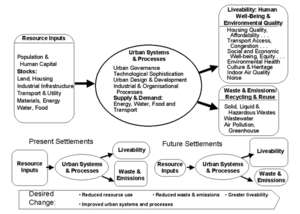The Extended urban metabolism model is an effort to model, conceptualise and support measurement of the sustainability of an urban region. It was developed by Prof Peter Newton, Prof Peter Newman, and Dr Bob Birrell among others while developing the Australian State of the Environment report in 2001.

In brief, it conceives of a city as a "metabolism", where the inputs are various types of resources such as energy and materials, the desired outputs are human wellbeing and prosperity, and the negative outputs are things such as waste, pollution, etc. Thus is this framing, the goal is to reform cities through behaviour change of residents and better urban planning so the desired benefits of cities can be maintained and increased, while reducing the throughput of physical resources needed and reducing negative externalities.
To understand a cities' performance in terms of the urban metabolic model would require a corresponding indicator frameworks project to be set up.
See also[edit | edit source]
- The concept of Sustainable well-being and ways to measure this.